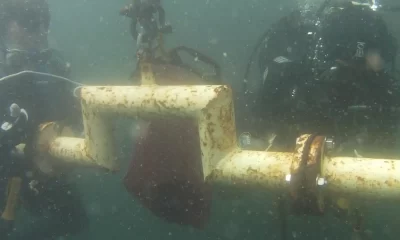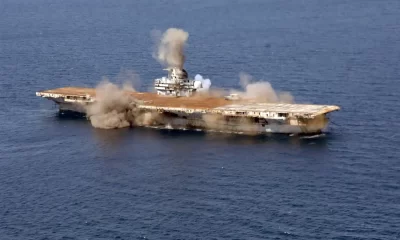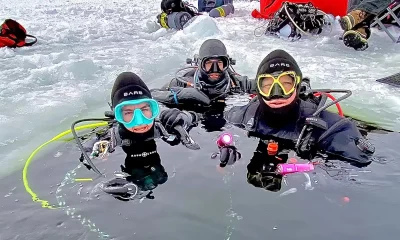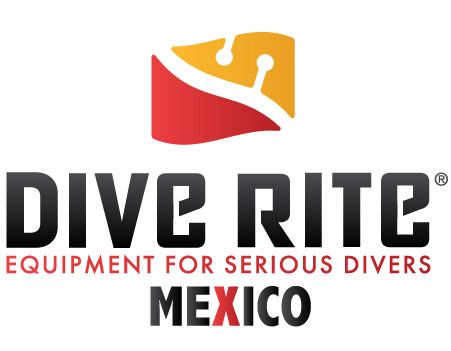Latest Features
OSHA vs. The Houston Aquarium: What Constitutes A Scientific Dive?
The Houston Aquarium recently won a pitched legal battle against the Occupational Safety & Health Administration (OSHA). At stake was whether the aquarium’s fish-feeding, scientific divers should be required to meet the more rigorous commercial diving regulations. As British dive journalist Victoria Brown explains, the case has served as a wake-up call for diving scientists to modernize their diving standards and establish global buy-in.

by Victoria Brown
Header photo courtesy of the Downtown Houston Aquarium
Disgruntled employees, unwanted Santa outfits, 19th Century brotherhoods, and knowledge of different types of algae? We take a detailed look at the almost decade-long litigation that has plagued a very public, but little-known, tentacle of the scientific diving community. The good news? This saga could inadvertently prove to be the catalyst for modernizing this self-regulating community of divers.
Landry’s Downtown Houston Aquarium has recently won an eight-year long legal dog fight against the U.S. Department of Labor’s Occupational Safety and Health Administration (OSHA). The latest ruling, one that has not and now cannot be challenged by the Department, ruled in favor of the Aquarium, finally putting the matter to rest. Despite this being described as “the battle of our time” by the Houston Aquarium’s Corporate Dive Program Manager, Todd Hall, scientific divers across the USA—and the world—have been relatively silent on the matter, and the win has been under-celebrated.
If OSHA had challenged the ruling. it would have seen the case tried in the Supreme Court, the highest court in America. In this article, we dive under the surface of the case and draw attention to how this landmark ruling could benefit the global scientific diving community in years to come.
Scientific Diving Guidelines
The guidelines governing scientific diving were born out of challenges to the original 1977 OSHA publication of standards for commercial diving operations. These applied to any diving in the natural or artificial inland body of water, as well as diving along the coast of the US and other listed territories. These standards made no provisions for diving performed solely for scientific research and development purposes, despite many dive programs operating safely and independently before the publication of the standards.

The educational institutions who championed this niche in diving quickly argued for exemption on the grounds that there were already standards in place before the OSHA publication, pointing to the University of California Guide for Diving Safety adopted in 1973. Furthermore, and perhaps more poignantly, they cited their impeccable safety record which was a result of efficient self-regulation.
The main crux of their argument was that the educational/scientific and commercial diving conditions are not congruent, therefore they cannot be subject to the same standards. This pressure led to OSHA deciding, in August 1979, to officially look into the matter, as they wanted to better understand the issue at hand. This move on the part of OSHA opened the gateway for non-educational scientific diving organizations such as the American Academy of Underwater Science (AAUS) to be formed, strengthening the case for exemption.
The scientific diving community proved victorious on November 26, 1982, when OSHA, after extensive consultation and public hearings on both the east and west coasts, granted a dispensation to divers that met their definition of scientific diver. [Recreational diving instruction was also deemed exempt from commercial regulation]. They also stipulated that scientific divers must operate under a diving program that utilized a safety manual and that had an adequate diving control board in place. In a bizarre twist, this was challenged by the Brotherhood of Carpenters and Joiners Union, which filed for a judicial review, seeking further guidance on what type of enterprises could be exempt.
This legal challenge led to the publication and adoption of the guidelines in place today, fatefully titled, “Commercial Diving Operations-Exemption for Scientific Diving-Final guidelines.”
These guidelines stated that the exemption is valid as long as the diving programs operated under a diving control board with autonomous and absolute authority, utilised a diving manual covering all diving operations specific to the program including standards and practices, emergency assistance plans that cover recompression and evacuation, as well criteria for diver training and certification.
The Case Against The Aquarium
Fast forward to 2012, and this exemption became the fighting ground for an appeal by the Downtown Houston Aquarium for relief from approximately $20,000 worth of penalties issued by an OSHA inspector, who during an inspection had applied commercial diving standards to the program despite its scientific status. It was not the cost of the penalties that spurred the appeal but the implications of accepting the inspector’s citations. This included the associated costs of adapting the program to commercial diving standards and, more importantly, the potential increased risk to divers of applying those standards.

It was a tough pill for this little known part of the scientific community to swallow given its good safety record, and there was also the danger of a domino effect with other programs being treated in the same way, something which would seriously hinder future research from both a financial and safety point of view.
Indeed, this created unrest among aquarium programs causing some to make the costly switch to commercial standards in anticipation. Mauritius Bell, the president of the Association of Dive Program Administrators (ADPA) and program administrator at California Academy of Sciences, reported in an interview that in a recent ADPA survey of their members, more than 50% of zoos and aquariums were operating under commercial standards. He believed that the percentage would have been much lower before the citation.

The Landry’s Houston Aquarium operates a six-acre entertainment complex with a 500,000-gallon aquatic tank that houses over 300 species from all around the globe, reptile and bird exhibits, large dining halls, and a selection of white Bengal tigers amongst their jam-packed entertainment attractions. Despite this touristic facade, Landry’s Aquarium also operates as a scientific research center and the tanks are maintained as best as possible to replicate the natural ecosystems for marine life.
In 2011, a employee who was partaking in the diving program was asked to leave his post apparently after a disagreement relating to a Santa outfit. This disgruntled employee, in turn, complained to OSHA and accused Houston Aquarium of not following the commercial diving standards on dives they executed as part of the daily aquarium operations. He sent OSHA portions of the Code of Federal Regulations, along with his complaint detailing his concerns with the diving practices, and accusing Houston Aquarium of not following commercial diving standards on dives that, it could be argued, were not for the purposes of data capture.

OSHA—and rightfully so—has a policy of deploying an inspector to investigate any complaints of this nature. Mark Chapman, the local Compliance Health and Safety Officer, was assigned to the case, and after visitation, deemed that everything was in order according to the scientific diving exemption of the commercial diving regulations. Chapman documented the aquarium’s stringent record-keeping across a long history, that their appropriate dive medicals were in place and up to date, and that all safety equipment was in the right place.
These findings were challenged by the ex-employee who lodged a further complaint with the national OSHA office, leading to a second investigation in February 2012. During this inspection, Chapman uncovered new evidence that formed the basis of the Citation and Notification of Penalty that was issued on July 10, 2012. It was determined that divers who clean the tanks and feed the animals were not conducting scientific dives, and, as a result, those dives were subject to the more stringent commercial diving operation standards. This is the only time OSHA has issued such a citation to an aquarium program that claims scientific status.
It was determined that divers who clean the tanks and feed the animals were not conducting scientific dives, and, as a result, those dives were subject to the more stringent commercial diving operation standards. This is the only time OSHA has issued such a citation to an aquarium program that claims scientific status.
What is a Scientific Dive?
The aquarium realized the potential impact on the broader scientific community, as well as their program, and decided to appeal. This led to the case being heard by an Administrative Law Judge (ALJ) in February 2019, a little less than seven years later.
The proceedings identified three types of dives: feeding/cleaning dives, event dives, and mortality dives (during which dead animals are removed and taken to the Aquarium’s lab for examination). During the initial three- day hearing, the ALJ ruled some activities did not fall within the exemption, namely the feed, clean, and event dives. Consequently, on February 15, 2019, the majority of OSHA’s Review Commission panel affirmed the ALJ’s determinations that these did not meet the plain text definition; interestingly, the Chairman of the Commission dissented.
The aquarium conceded that the event dives were extraneous to the scientific research being conducted, but strongly disagreed that the feed and clean dives could be seen in the same light, chiefly because these dives underpinned the research conducted by the aquarium. It was reported at the time that Landry’s general counsel and executive vice president, Steve Scheinthal, was of the opinion that OSHA had overstepped its bounds and vowed to appeal. His challenge to the ruling was launched on April 16, 2019, when the aquarium, led by senior diving officer Todd Hall, petitioned a higher court to review the judge’s ruling, focusing on the decision to side with the lay testimony of an OSHA Compliance Officer whilst excluding expert testimony.

Furthermore, they took issue with the OSHA declaration that the application of commercial diving safety regulations should be enforced on the aquarium because they were not performed by “employees whose sole purpose for diving is to perform scientific research tasks,” despite it being substantiated during the hearing that the Aquarium’s employees all hold scientific bachelors and masters degrees. Another citation was issued for not having decompression tables at the exhibits, but they were proven to be nearby in the dive locker which was fully accessible by the divers. All in all, there were many grounds for a challenge.
And so we arrive back at the landmark decision reached by the fifth circuit Federal Court Of Appeals (just below the Supreme Court) in July of this year, which can no longer be contested by OSHA. The court was sensitive to the fact that the divers completing these activities are trained scientists and learned that there was a requirement for them to observe animal health and behaviors, eating patterns, and the types of algae growing in the tank.
Furthermore, during the appeal it was proven that this information was recorded upon completion of their dives, thus meeting the criteria of data capture which is the basis for the criteria of what defines a scientific dive. The court also listened and agreed with expert testimony stating that adhering to the OSHA commercial standards in the context of a scientific dive would make the divers and animals “less safe.” Indeed, Todd Hall had testified from the beginning that this was the case, pointing out that a diver could get to the surface quicker than switching to a second air supply and that extra equipment in the exhibits created a hazard to the animals. When asked to comment on the ruling Hall said, “It took eight and a half years to come full circle. The take away was that we were right all along because the judge used our exact logic from day one of why we were safe and why more equipment doesn’t make us safer.”
The Quest for Global Scientific Diving Standards
This was not just a victory for one aquarium, as over the last few months many that had made the switch to the OSHA commercial standards have quickly reverted to the more appropriate and safer scientific standards that they followed before the 2012 citations. It could also be argued that this was also a win for the scientific diving community as a whole which, through organizations such as the American Academy of Underwater Sciences (AAUS), has been vocal that there is a need for more clarity from OSHA on the criteria for exemption.
Jessica Keller, a NOAA employee and the current secretary of AAUS, believes this is a long-standing issue. “There’s a question of when to apply commercial diving standards vs. when to apply the scientific exemption. We needed clarification in these grey areas.”
When speaking with her colleague Derek Smith, President of AAUS and a previous expert witness for the Aquarium put forward by ADPA, he echoed Keller’s sentiment and sees this very much as the beginning rather than the end of the matter. “Celebrating the victory is short-lived, as this landmark is cementing the practices followed not only by the Houston Aquarium, but a large majority of aquariums across the USA and the world,” he said. “It’s a silent victory about practices they have carried out for years and years. I believe there is now the opportunity to dive headfirst into a new battle and push for updating of the standards for Commercial Diving Operations (CDO) and its exemptions.”
It must be noted—and this was highlighted by Derek Smith—that the ruling pertains to the three states that the Fifth Circuit has jurisdiction over, and cannot fully be used as a precedent. Having said that, he went on to say that it is certainly a case that can be referenced. The AAUS has offered to work with OSHA in assessing exemption claims; as an organization that oversees the standards for one hundred and fifty-two scientific diving programs, AAUS argues that they are better placed to make the call on what is exempt, since they have access to decades of accrued data.

Derek Smith confirmed that the AAUS has begun this partnership work and is hopeful that this will prevent any other aggressive and baseless enforcement against programs claiming exemption. Keller also celebrated this move, stating, “The most important thing is now we have opened the lines of communications, and I’m glad that OSHA is interested in having a better pulse on what’s happening in the field.”
This case has also given rise to conversations around the modernisation of the standards followed by scientific divers and the benefits to science this could yield. For example, Todd Hall believes that using a rebreather would allow for closer and improved observation of the animals, as well as minimising the impact on the ecosystem.
The ripple effect has not stopped there, as the global scientific community looks to the US when setting standards. Smith and the AAUS are certainly playing a role in painting what that future looks like for the community as a whole. When asked to talk about what is next, Smith passionately explained:
We are trying to unify everyone on a world level. I’m heading up (for the AAUS) a scientific diving training council which is akin to the recreational scuba training council, we have all the major scientific diving standard-setting organizations across the world to agree to a common standard that we will all follow. It’s at the stage now where it’s going out to all our boards, Canada, the US, Mexico, and we have about 100 countries represented so far. [We are seeking] unified training standards so we can enjoy some level of formal recognition of prior training so scientists can move freely across the world to work.
According to Smith, the goal is to establish a global organization that will mirror the role that The World Recreational Scuba Training Council (WRSTC) plays in recreational diving in protecting the worldwide safety of the recreational diving public, primarily through the development of worldwide minimum training standards. The World Scientific Diving Training Council (WSDTC) was established last year, putting foundations for minimum training standards into the ground. This is a tall task, as there are no doubt some territories that have their own entrenched standards. For example, the Health and Safety Executive in the UK has a strong hold on this type of diving dating back to the Diving at Work Regulations 1997, Approved Code of Practise and Guidance.
The World Scientific Diving Training Council (WSDTC) was established last year, putting foundations for minimum training standards into the ground. This is a tall task, as there are no doubt some territories that have their own entrenched standards.
What will be the impact of this global action? Keller was quick to point to the the potential benefits, both in the short and longer term, of this new consolidated way of working in the scientific community:

Let’s create this global minimum standard for science so that reciprocity and international collaboration can be easier and so we can trade information. Our oceans are in trouble with sea level rise, and we need to understand it better. Moving forward we need it to be easier. If we can get our own house in order that will help us globally, [and] having an organization to help set these standards will help save the world.
This is yet to be proven, but what is more certain at this point is that this sensational court case has drawn attention to the fact that scientific diving has self-regulated without incident for the pastthree decades. It could be viewed that the case was an unnecessary eventuality born out of a plot of revenge by a disaffected actor; but, it could also be viewed as a necessary evil that may just have ensured that this community of divers continues to keep each other safe.
Dive Deeper
- The Secretary of Labor vs. Houston Aquarium Inc.
- Oral Arguments: The Court Recordings
- American Academy of Underwater Scientists
- OSHA Commercial Diving Operations (CDO): 1910 Subpart T App B – Guidelines for scientific diving
- OSHA EXEMPTION, AAUS, AND SCIENTIFIC DIVING
- Health & Safety Executive (HSE): Scientific and archaeological diving projects. Diving at Work regulations 1997. Approved Code of Practice and guidance
- European Scientific Diving Panel (ESDP): The European Scientific Diving Panel (ESDP) acts as an operational platform to advance underwater scientific excellence and to promote and implement a practical support framework for scientific diving related activities.
- University of California Santa Barbara: Dive Safety Manual Standards For Scientific Diving
- Scripps Institution of Oceanography University of California, San Diego: Manual for Diving Safety

Avidly exploring the underwater world since she was twelve, Victoria Brown has been a professional diver for sixteen years and is now based back in the UK following many years touring the snowiest peaks and deepest green seas. From safety diving on media projects to creating content for the coolest brands in the diving industry, she has diving written all over her.





















































